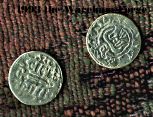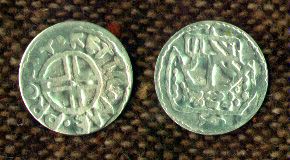the Wareham Forge
Each of these sterling silver coins is struck by hand using coin dies reproducing those found in York, England circa 950 AD.

"Silver Penny One"
Coin shown about life size - both sides.
(left) Samples of this coin have been found throughout England and as far away as Denmark. At York, a die for stamping this coin was found at the Coppergate site. The Latin inscription has been interpreted as "the money of St. Peter" and is thought to refer to the cathedral at York. As well the coin bears a sword and Thor's hammer, both symbols of the pagan Vikings.
ANLAF GUTHFRITHSSON, c. 940
(right) This is another coin struck at York, which was ruled by a series
of Norse kings during the 10th century. It bears the king's first name,
as well as his royal title, "CUNUNC". In the centre of the coin is the
figure of an eagle.

"Silver Penny Two"
Coin shown larger than life size - both sides.
(left) This is the reverse of the original coin. It bears two elements common to many Viking Age coins. First is the 'circle cross', suggesting the growing importance of Christianity as the state religion. (Or are these merely cutting marks?) The second is the text - 'Kettil the Moneyer' (in latin). In this case I have used the name I use in living history presentations as the minter of the coin.
'Birka Grave Coin' c. 825
(right) This coin is from (as the name suggests) a grave found at Birka Sweden. Dated to about 825, it is one of the earliest coins minted in Denmark, and thus a sign of the influence of Birka as a trade centre. It bears a longship design, stressing the importance of the ship to the Norse.
Some notes on Viking Coins
A small bar shaped ingot would be cast in a stone mould from silver. This bar would be hammered into a strip of suitable thickness. Each coin blank would be then cut from this strip, the scrap being formed into new ingots. The blank would then be placed between two dies, one mounted in a stump and the other hand held. The upper die would be struck with a heavy hammer to make the impression. A 'double strike' coin, caused by repeating a poor first blow, would be rare.
VALUE
The stamp of each king would be a guaranty of silver content (purity), which varied considerably between reigns. The standard Anglo-Saxon penny, was an average 1.5 gms. This weight was standard for several centuries in England. The English conversion rate of 20 pennies to the ounce defines our modern unit of pennyweight With the start of the 'danegeld' payments in the late 9th centuries, the penny was debased to about half its former value to reduce the impact of these payments, which were based on the Norse system of measurements. Note that this refers to silver content, not total weight. The Norse system of measures is based on the following, note that the values are converted to grams of pure silver.
1 peningar = about .78 gms silver
1 eyrir = 30 peningar
about 24 gms silver = cost of 6 ells (yards) of wadmal (wool cloth)
1 mark = 240 peningar or 8 eyrir
about 200 gms silver
USE
Because of the use of hand hammered and cut blanks, there would be some variation in total weight between each coin. As well, the absolute content in silver would vary, depending on when and were each coin was minted. Each coin would therefore be weighed, to determine its 'real' value.
Change was commonly made by cutting up the coin and returning a fragment. This practice was most common in southern Scandinavia. (As a side comment: The modern slang term for a quarter, as 'two bits' comes from the later use of the Spanish Doubloon. It was marked with a cross shape that allowed accurate cutting into 8 sections. It was also referred to as a 'piece of eight', thus a quarter of it would be 'two bits'.)
Such fragments are commonly found in silver hordes from the period (one element of so called 'hack' silver). In a violent world without banks, valuables where often buried for safety by owners who never returned.
Hold a piece of history in your hand!
Order a SILVER PENNY from the Wareham Forge
Each solid sterling silver coin comes packed with an information card
$15.oo CDN
(Canadians + HST)
This silver penny (No. One - known locally as a 'Silver Sylard') also serves as the Wareham Forge trade
token.
Redeemable at any time for $10 worth of goods!